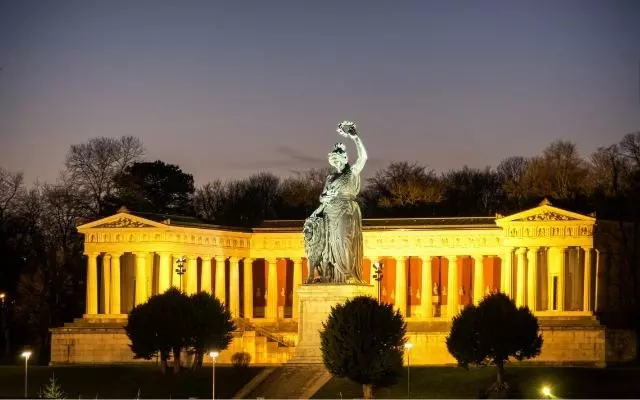The Bavaria Statue is the name given to the colossal well-known effigy of Lady Bavaria in Munich that surveys the western side of the Theresienwiese in Munich City.
Known locally as Lady Bavaria, the Bavaria Statue Munich stands tall and proud and is a testament to all patriotic Bavarians. The Bavaria Statue commands this entire area of Munich and is an effigy representation of the wealth and might of the powerful State of Bavaria.
Cast entirely in bronze this behemoth that is the Bavaria Statue is a magnificent piece of engineering the like of which had not been seen since the period of Europe’s classical antiquity.
We’ve visited Lady Bavaria many times, and after we tell you all about her, we hope you’ll go and say hello (Grüß Gott) as well.
The History of Munich’s Bavaria Statue
The construction of the Bavaria Statue Munich has been timelined over a period of 13 years during which King Ludwig I lost his crown and the original architect died having never seen the completion of his vision.
Part of a planned TRIO of architectural installations in Munich designed to add to Ludwig’s vision of making Munich the “Athens on the Isar”, the Bavaria Statue originally evolved as part of an entry to a competition held between prominent and artistically inclined Bavarians.
The other two installations planned were to complement and showcase the incredible size of the construction and they are the huge sweeping staircase in front of Lady Bavaria, and the Ruhmeshalle (“hall of fame”) that spreads out behind her.
With its final design attributed to the famous sculptor, the aptly named Ludwig Schwanthaler, the statue was produced in Bronze by metal founder J.B. Stiglmair with the assistance of his nephew Ferdinand von Miller in their local Munich foundry. Because of its gigantic size, the statue had to be made in several different parts which were put together like a jigsaw puzzle in order to complete the entire construction.
The sand casting method was utilised in the build by Stiglmair’s Royal Metal Foundry (Königliche Erzgießerei) which was based on Munich’s Nymphenburger Strasse, with the head of the Lady Bavaria being the first part cast in 1844. After some financial difficulties with the project, the last major piece to this architectural wonder was cast in 1849 and the whole thing came together for a grand unveiling on 9th October in 1850.
And the Bavaria Statue has stood strong and solitary ever since!
All About Munich’s Bavaria Statue
Tall and proud the Lady Bavaria was considered a wonder at the time and was noted as a sort of a “blueprint” for other major statues planned and constructed about the globe. The Bavaria Statue was in essence, the mother of all these other globally recognised statues, the most famous among them being the statue of liberty in New York.
The Bavaria Statue:
- Is 18.52 metres (60 ft. 9 in.) high
- Weighs in at almost 88 tons
- Sits on a bed of stone which itself is almost 9 metres (28 ft.) high
- Represents the strength and glory of Bavaria
- Holds a wreath in her hand as dedication to Ludwig himself, Munich’s most generous patron of the arts
- Stands aside a huge lion which signifies the strong defensive capabilities of Bavaria
- Was cast first as a life size model in plaster
- Is clothed in “Germanic” style featured flowing robes and bearsking garb
- Has a head cast in bronze from a reclaimed Turkish canon
- Cost 286,346 guilders to design and construct
- As a symbolic structure was readily used for propagandistic staging by the Nazis
- Was closed off and renovated in 2001 when over 2000 separate flaws were detected
- Has a full size copy of its hand only in the metallurgy collection within the Deutsches Museum
Secrets of the Bavaria Statue in Munich
The Lady Bavaria has stood for so long that you’d think she’d have revealed all her secrets by now and truth be told, she probably has. So we don’t feel like we’re betraying her to let you guys in on the biggest secret of the Bavaria Statue – you can Get Inside her Head!
You wouldn’t think so to look at her from the outside but there are 120ish steps inside the statue that lead to expansive views across the city from the very small observational points within the head.
But beware – Getting in Lady Bavaria’s Head is not recommended on those few very hot days in Munich where the sun turns this metal structure into a steam room that’s not for the faint of heart.
There are tiny sitting places at the top of the staircase and several small windows from which to view Munich. The Bavaria Statue Munich can be particularly resplendent as the evening light fails and the lighting illuminates the statue and Ruhmeshalle behind her.

Munich Monuments: Lady Bavaria Is Everywhere!
Throughout the City of Munich, there are other representations of Lady Bavaria scattered about as well as in other towns and cities within Bavaria.
Most notably you can find Lady Bavaria atop the Temple of Diana in the Hofgarten, outside of Munich’s Residenz standing within the mighty columns, and riding Bavaria’s famous Victory Gate – the SiegestorMunich!
Where is The Bavaria Statue in Munich? How Do I get There?
Getting to Lady Bavaria in the Theresienwiese from central Munich is very easy with the simplest way being via the underground train system (U-Bahn). The U4 and U5 lines of the U-Bahn have a station actually called Theresienwiese, but the closest U-Bahn station to the Bavaria Statue is actually Schwanthalerhöhe to the west.
If you arrive in central Munich by S-Bahn you can easily walk in fifteen minutes from Hackerbrücke to Munich Festival Grounds and there are many buses that pass nearby to the area.
Walking from Marienplatz in the city center will take 25-35 minutes depending on your walking speed and fitness.
Consult one of our Munich Maps for more of an idea, or check out the Munich Public Transport Website for more details on Getting to the Bavaria Statue.
Opening Hours and Dates of the Bavaria Statue
9am to 6pm are the general hours that you are able to visit the Bavaria Statue and the Hall of Fame (Ruhmeshalle) behind her and the cost was €5 last time we visited.
These monuments are administered by the Bavarian Palace Department which can offer money-saving Palace Passes that will get you into a multitude of palaces, gardens, and more within the city. Click HERE for more details.
Both of these awesome Munch Monuments are open from April through to October but of course, can be viewed all year round externally as they are public monuments on public land. During the Oktoberfest weeks, there are extended hours for visitors to Lady Bavaria.
Location Map of the Bavaria Statue
Munich’s famous Bavaria Statue is located at:
Street Address: 16 Theresienhöhe, Munich, 80339, Germany
Co-Ordinates: 48.1307, 11.5459
View on Google My Maps | Get Directions on Google Maps
Bavaria Statue Munich: Will you Visit Lady Bavaria?
Now that you know all about her – The Lady Bavaria…will you make the time to drop by and visit her here in Munich. You know her secrets now and you’ll really be able to Get in her Head if you visit here at the right time of the year.
The Bavaria Statue Munich is just one of many Absolutely Amazing Munich Monuments and as our blog grows and develops we’ll cover a lot more of them for you!
Nearby to here (just five minutes) you can find the Endless Staircase of Munich and the Bavariapark with its leisurely statue walk, both of which are worth having a look at.
We hope to see you out here at the Theresienwiese sometime! Take care and thanks for reading.


